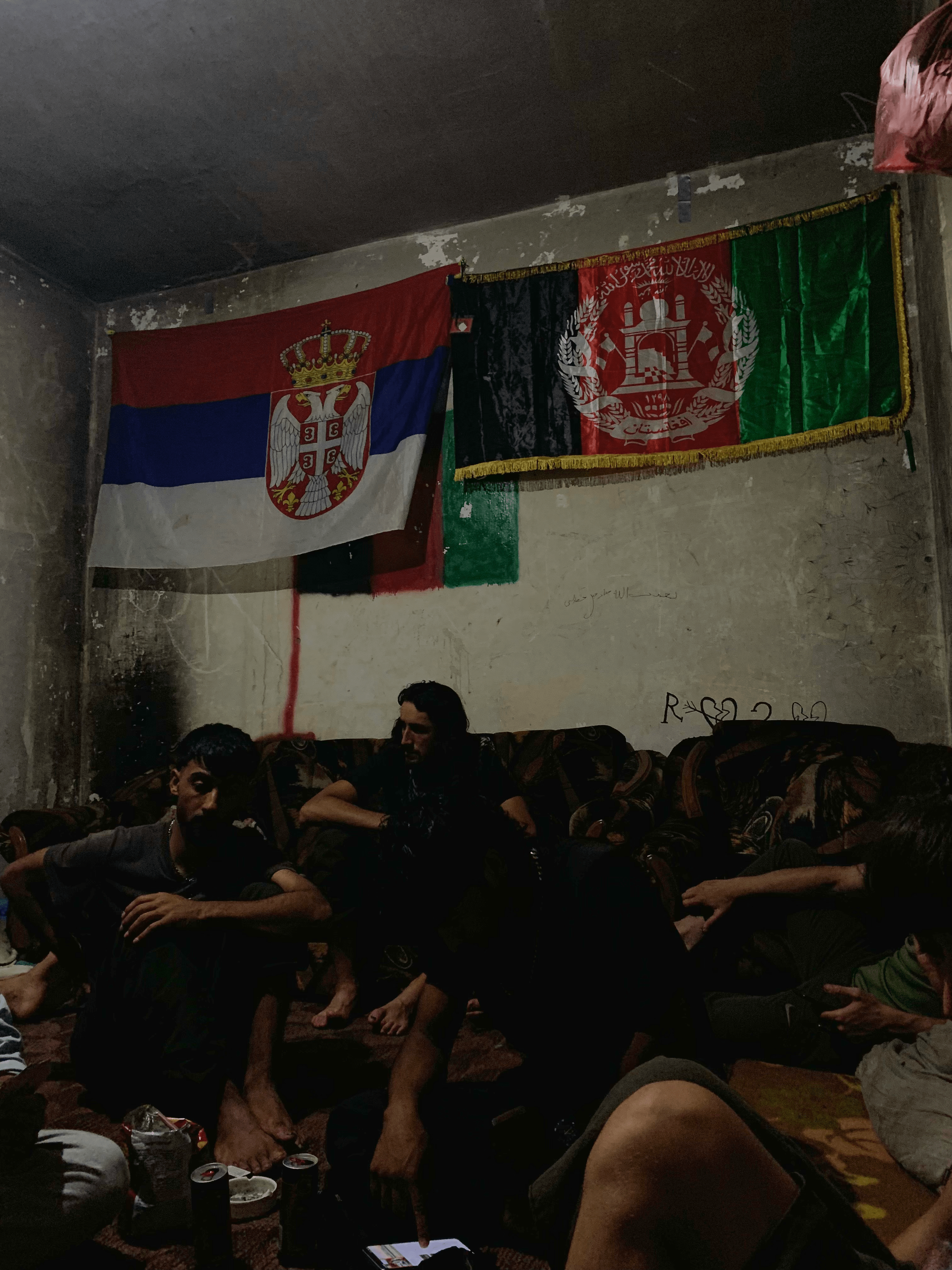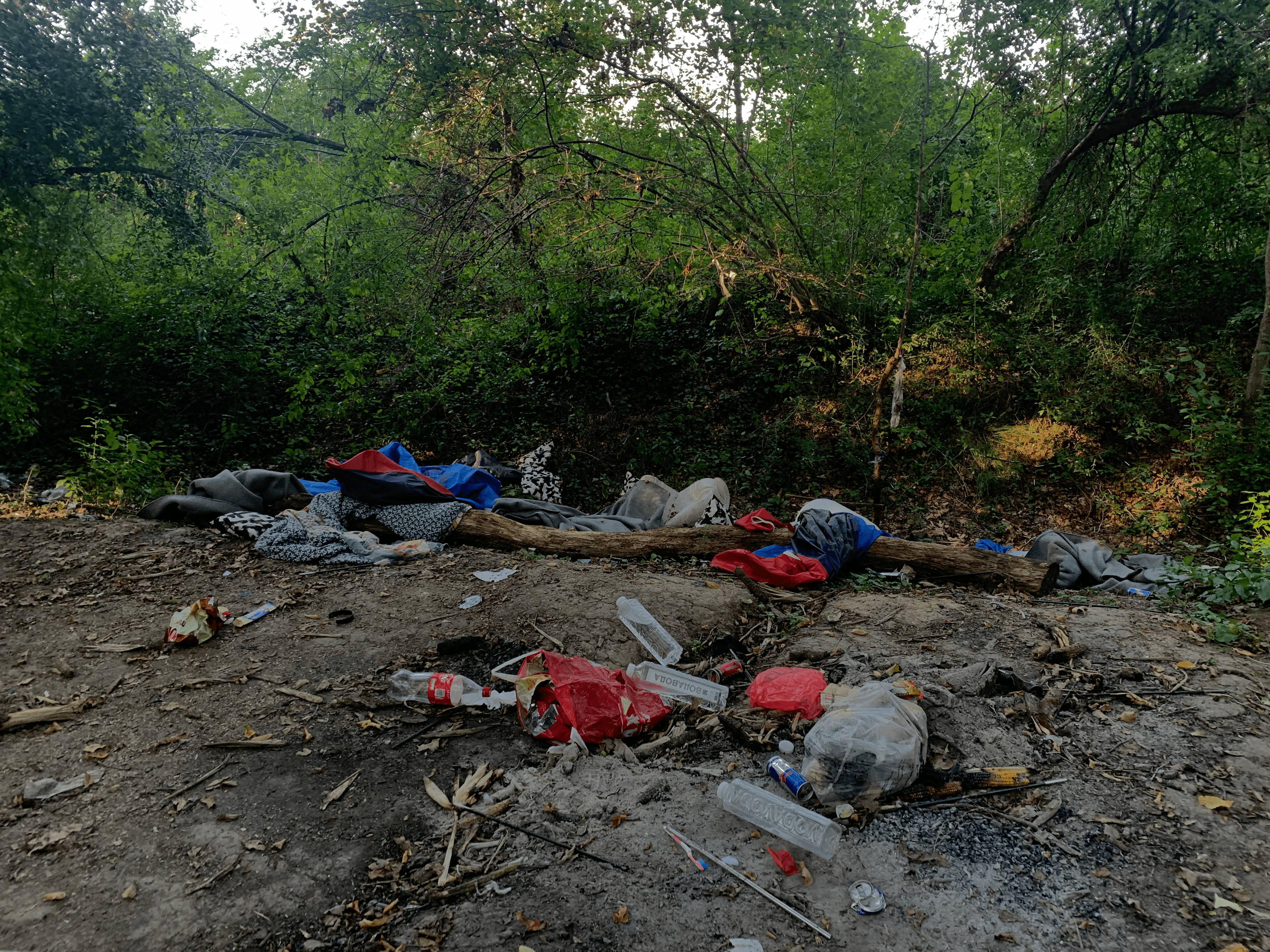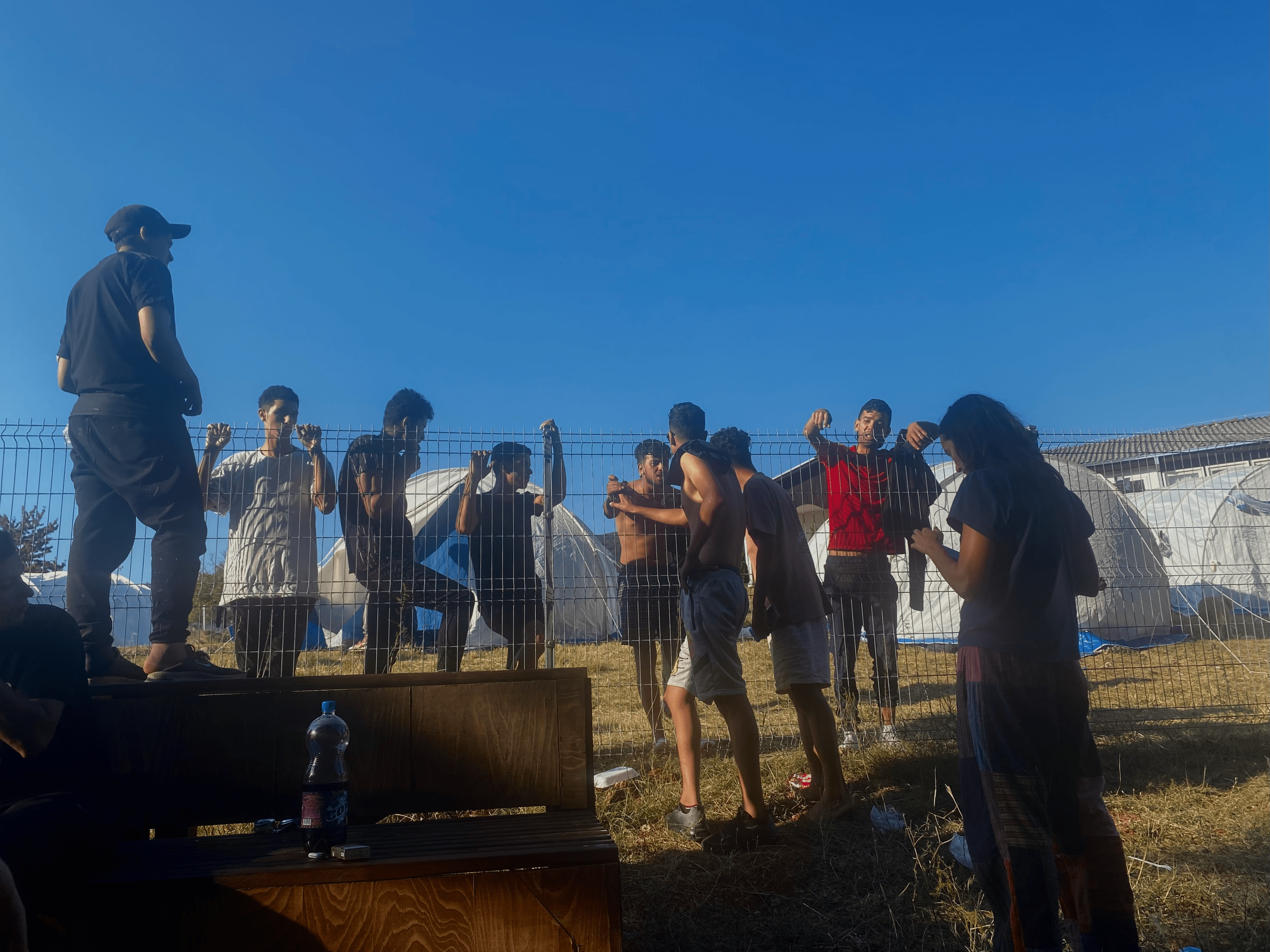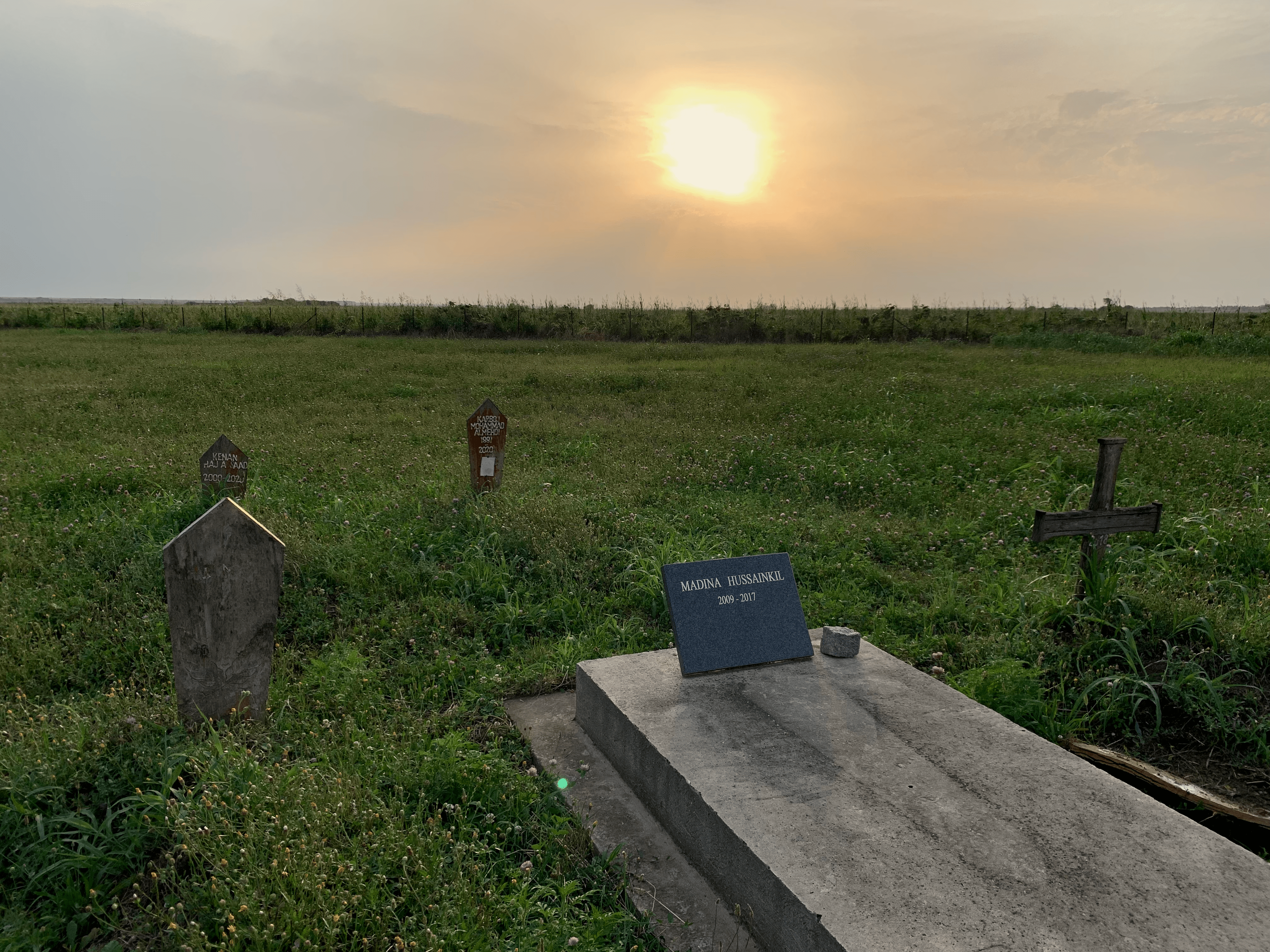“We are better here than in Belgrade,” 19-year-old Abid Tasal tells me as we talk in Sjenica asylum center, in southern Serbia. He sits in a wheelchair, his left leg heavily bandaged and his right arm in a splint. He explains that these injuries occurred when he was in Belgrade, in August 2024. While sleeping in an abandoned building, he and others heard police approaching. Panicked, they jumped out of a window in a desperate attempt to escape.
Serbia is a key transit country along what is known as the Balkan Route, a main pathway for people on the move — refugees, asylum-seekers and migrants — attempting to reach the EU. In 2015, there was a surge of people on the move fleeing the Syrian civil war, as well as from other states facing poverty and instability, on the Balkan Route. Over one million people arrived in Europe by sea that year. Since then, the route has left thousands of asylum seekers stranded in legal and physical limbo.
The Balkan Route is now one of the most dangerous migratory paths in Europe. Humanitarian organizations report and document widespread abuse, including pushbacks. Pushbacks are when individuals trying to cross into an EU country are returned back to the non-EU country they entered from, often without the opportunity to apply for asylum. Pushbacks violate the non-refoulement principle in the 1951 Refugee Convention, which all EU states have ratified. Border authorities including the European Border and Coast Guard Agency (Frontex) commonly employ pushbacks at the EU’s external borders.
People attempting to reach the EU are also subject to physical and sexual violence, arbitrary imprisonment, robbery and intimidation. In some cases, camp doctors have prescribed them psychotropic medications; they have been stripped and their belongings burned; they have faced intimidation with dogs and deployment of a “special water” that causes severe skin reactions.
Agreements like the 2022 memorandum between Austria, Hungary and Serbia and the European Commission’s agreements with Bulgaria and Romania on border cooperation have made such practices more frequent. Such agreements aim to harden border controls on the EU’s external borders and streamline asylum and return processes.
Additionally, the EU Parliament passed the New Pact on Migration and Asylum in April 2024, which was then approved by the Council of the European Union in May 2024. The pact further hardens EU borders through new border control mechanisms and partnerships with neighboring and transit countries, while also allowing member states to buy their way out of accepting their proportional share of EU asylum seekers.
Amnesty International and Human Rights Watch denounced the pact as “a disaster for migrants and asylum seekers,” and it has made crossing the Western Balkans a game almost impossible to win. “The Game” is how people on the move refer to attempts to cross borders.
Bulgaria, where pushbacks mark the start of “The Game”
I met 24-year-old Hamza, whose name has been changed to protect his administrative status, in an informal settlement near the Serbian-Croatian border a year ago. He fled Afghanistan in 2022, after being threatened by the Taliban due to his work as a journalist and said he was pushed back 10 times by Bulgarian border police. “10 times I tried to cross, and 10 times I was pushed back to Turkey,” he recalled.

Serbia is a key transit country for people on the move, including those from Afghanistan. Photo: Marta Moreno Guerrero.
I collected Hamza’s testimony while volunteering for No Name Kitchen (NNK) in 2023. NNK is a nongovernmental organization active in the region since 2017. It has collected thousands of testimonies like Hamza’s to document and condemn border violence while providing legal support, medical care and distributions of food and clothes to people on the move and denouncing abuses at the borders.
According to data from the Bulgarian Helsinki Committee, in 2022, there were 5,270 pushbacks involving 87,650 people at Bulgaria’s border with Turkey. Bulgaria’s entry into the Schengen Area on March 31, 2024 exacerbated the situation, as border controls were strengthened to align with Schengen requirements.
These actions are part of the Framework for Cooperation on Border and Migration Management, agreed to in March 2024. This agreement, which includes both Bulgaria and Romania’s commitments on migration, was a condition for their partial admission to Schengen. Bulgaria receives 85 million euros from the EU’s Border and Visa Management Instrument through this framework.
Bulgarian border police reported three-and-a-half times fewer crossing attempts in 2024 compared to 2023. Activists with Medical Volunteers International (MVI) told me that this is a result of increased EU investment in Bulgarian border enforcement. Between January and May 2024, 15,000 crossings were “prevented,” compared to 55,000 during the same period in 2023. When official reports use the term “prevented,” it is usually a euphemism for pushbacks, which violate the principle of non-refoulement.
“They stripped us naked, stole our belongings, and beat us with batons until we couldn’t move,” he said.
Hamza described how the police found them three days after crossing the Turkish-Bulgarian border with 25 others from Afghanistan. “They stripped us naked, stole our belongings, and beat us with batons until we couldn’t move,” he said. “They unleashed dogs on us and laughed as they attacked,” showing photos of his injuries. After the assault, they were loaded into cars and returned to Turkey without any opportunity to claim asylum, a violation of the non-refoulement principle.
After making it through Bulgaria, Hamza found himself in Serbia just as it agreed to launch a joint police operation with Hungary aimed at “fighting organized crime and irregular migration.” On August 23, 2023, he warned an NNK team over Whatsapp not to come to the settlement he was in.
“Don’t come today, the police have destroyed everything,” his message said. By the time the team arrived, the settlement was completely demolished and dozens of people were evicted. Hamza was lucky and managed to hide from the police. Two days later, he “continued to The Game” and a few weeks later, arrived in Germany, where he is still waiting for his asylum case to be resolved.
His message was emblematic of the new wave of violence against people on the move in Serbia.
Serbia is turning into a prison
Saad Ahmed, a 25-year-old Iraqi Kurd, avoided Bulgaria but had a similarly perilous journey: “We crossed Greece and Macedonia, and from Macedonia, we walked to Serbia. For three days, we were lost in the mountains before finally reaching Serbia,” he told me.
Ahmed and his group first arrived in Belgrade, where they encountered Ahmad Nashat, a 20-year-old biologist who is also an Iraqi Kurd. The two connected with a larger group of Kurds in Serbia. Some members of the group met in a park in Belgrade while resting, while others joined them here, at the transit camp in Sjenica. In 2023, 21 camps — reception/transit centers or asylum centers — operated in Serbia. The number of camps operating at any given time fluctuates due to rapid shifts along the Balkan route.

People on the move on the Balkan Route often have to travel through remote areas to avoid detention. Photo: Marta Moreno Guerrero
“We were in a park [in Belgrade], the police suddenly appeared and, without any explanation, handcuffed us, asked us what we had on us and took our money. They stole me 200 euros. Saad was luckier, the officer who handcuffed him warned him to hide his things,” Nashat, the biologist, explained.
Ahmed added, “I was lucky, I guess. Not as my friend,” pointing to another group member. “The police saw him smiling and yelled at him, asking, ‘Why are you smiling?’ They slapped him to make him stop.”
The next morning, they were brought to court and each fined 100 euros. No explanation, receipt, or documentation was provided.
The entire group was taken to a police station in Belgrade, where they spent the night. The next morning, they were brought to court and each fined 100 euros. No explanation, receipt, or documentation was provided. “We just paid to avoid further trouble,” Nashat explained. They were then released without further details and arrived in Sjenica the following day. “This is the first meal we have in three days,” Ahmad said, looking at a box of chicken they took out from the camp.
Abid Tasal, seated in his wheelchair, listened to the conversation. “In Bulgaria, there were no problems, but once we got to Serbia…,” he added, while shaking his head. Tasal has been with his friend since they left Afghanistan two years ago. Both worked in Iran and Turkey to save money for their journey.
Despite the hardships, Tasal had not lost his smile. “I’m going to Switzerland to study engineering,” he said excitedly, pulling his friend close for a hug. “He’s coming with me.” They looked at each other and smiled. “In 15 days, we’ll be leaving,” he said and showed a paper indicating that he must leave the country in less than 20 days.
“But what about your leg?,” I asked.
Tasal gestured with his unbandaged arm resting importance to his injuries. “It’s not broken, just a sprain,” he reassured me, despite the cast around his ankle suggesting otherwise. The paper warned that failure to leave within the stipulated time could result in imprisonment.
The EU has been the largest donor to migration management in Serbia, contributing over 130 million euros since 2015 to support humanitarian aid and improve conditions in these centers. Nonetheless, the joint Serbia-Hungary police operation in 2023 led camps near Serbia’s borders with Hungary and Croatia to close. Individuals in those facilities were evicted to centers in southern Serbia, closer to the borders with North Macedonia and Bulgaria.
In late 2023, around 7,000 people were relocated from northern Serbia to camps near the Serbia-North Macedonia border. Such operations involved several hundred personnel from various units, including Serbia’s Special Anti-Terrorist Unit and gendarmerie, Serbian and Hungarian police forces, the Border Police Administration and the Serbian Criminal Investigation Police (UKP).
Additionally, strict movement restrictions have been imposed, raising concerns about potential violations of Article 5 of the European Convention on Human Rights, which guarantees the right to liberty and security. NNK observes that the joint Hungarian-Serbian operation “was presented as a strategy to combat people-smuggling organizations. However, the establishment of these camps reveals a strategy of population management grounded in segregation and violence.” Therefore, NNK argues, the camps’ establishment “exemplifies an ‘absolute power’ to confine individuals within a controlled spatial system, rigorously regulating their movement and severely curtailing their autonomy.”

People on the move held in camps in northern Serbia were relocated to facilities next to Serbia’s border with North Macedonia in 2023. Photo: Marta Moreno Guerrero
In December 2020, the Court of Justice of the European Union’s ruling against Hungary imposed a 200 million euro fine for non-compliance with EU law on Hungary. That non-compliance — pushbacks into Serbia — violated the principle of non-refoulement. Hungary now seems to be seeking to avoid the ruling’s consequences by preventing people from reaching the Hungarian border through increasing police harassment in Serbia.
The ongoing joint Hungarian-Serbian police operation has severely restricted people on the move’s movement in Serbia and impeded aid organizations. MVI noted that “increased militarization at the Serbian-Hungarian border” has “rendered settlements inaccessible to humanitarian aid.” MVI reporting shows a significant decline in patient numbers, from 1,395 in September 2023 to 811 in October 2023, and none in December 2023, leading the organization to cease medical check-ups and withdraw from Serbia.
The number of individuals registered in government-run reception and asylum centers fell by 73% compared to the previous year — from 24,640 in the first five months of 2023 to just 6,705 in the same period of 2024.
In May 2024, Nataša Stanisavljević, commissioner of the Serbian Commissariat for Refugees and Migration (SCRM), the Serbian government office in charge of migration management, released statistics highlighting a sharp decrease in the number of people on the move passing through Serbia. The number of individuals registered in government-run reception and asylum centers fell by 73% compared to the previous year — from 24,640 in the first five months of 2023 to just 6,705 in the same period of 2024.
According to Alice Pezzutti, an activist with NNK, this decline is due to the closure of most centers and forced evacuation of residents. “The closures were a strategy to prevent people from entering Serbia,” said Pezzutti. Per findings from the Border Violence Monitoring Network (BVMN), a collection of nongovernmental organizations in the region that collect and publish testimonies of border violence, the drop in the numbers in Serbia coincides with increases in camp capacity in Bosnia and Herzegovina.
A game that no one knows
The harsh reality of migration along the Balkan Route has pushed people on the move to the fringes of society. Those navigating this perilous route often find themselves living on the outskirts of towns, either relocated by police or hiding to avoid violent encounters with law enforcement.
Many of the remaining transit centers in the region are far from urban areas, severely restricting mobility. For example, the Adaševci transit camp in western Serbia is on the E-70 highway, nearly 30 kilometers from the nearest town, Šid, with the exit only accessible by taxi — there is no way to reach it using public transport.
NNK’s report underscores the deteriorating situation and the “carceral logic” of systematically harassing and disrupting migrants’ daily lives.
The plight of those arriving in the Balkans remains largely invisible to local residents. This neglect is evident in the cemetery in Šid, where graves are covered by uniform marble markers. But at the cemetery’s edge, where maintenance is lacking, a few wooden markers — many names faded or obscured by grass — stand in stark contrast.
Among them is a solitary tombstone engraved with the name Madina Hosseini. Hosseini, a six-year-old girl from Afghanistan, died after being struck by a train after a pushback by Croatian border police. Her grave, along with those of other victims of the Balkan Route, remains neglected, with no visitors to honor her memory. Until recently, Hosseini was “The Game’s” youngest known victim.

Graves along the Balkan Route, such as that of six-year-old Madina Hosseini outside Šid, Serbia, are physical reminders of the “The Game’s” deadly stakes. Photo: Marta Moreno Guerrero
Since early 2022, an estimated 155 unidentified bodies presumed to be people on the move have been found in morgues near borders in Bosnia and Herzegovina, Bulgaria and Serbia. The International Organization for Migration estimates that 389 people have gone missing trying to reach the EU via the Western Balkans since 2014.
On August 22, 2024, 12 people drowned while attempting to cross the Drina River from Serbia into Bosnia and Herzegovina. One was a nine-month-old baby. Other victims included 15-year-old Mustafa Abdulmajid Mohammad and 20-year-old Abdulwahed Hasan Ammar, both Syrian, who are buried in Saraj Cemetery in Tuzla, Bosnia and Herzegovina. One person who drowned has still not been identified.
Such deaths rarely receive media attention. In the “Dead and Missing in the Balkans” Facebook group, which tracks those who have disappeared along the route, Mohammad and Anmar’s families posted a statement saying “The journey they began with great hope turned out to be harder than they could ever imagine. Their lives were cut short before their dreams could be realized, leaving behind a painful memory and unfulfilled hope.”
In an abandoned settlement along the Balkan Route, graffiti reads: “I’m tired of being the victim of hate.” That message is lost when nobody sees that it reflects the deadly consequences of EU migration policies, which have turned the Balkan route into a deadly game.
Feature Image: Marta Moreno Guerrero
 Want to support our journalism? Become a member of HIVE or consider making a donation. Learn more here.
Want to support our journalism? Become a member of HIVE or consider making a donation. Learn more here.





